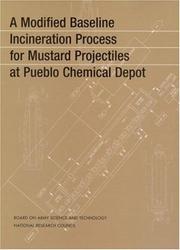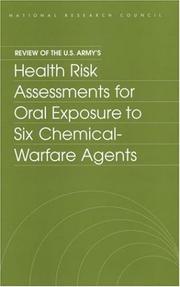| Listing 1 - 6 of 6 |
Sort by
|
Multi
ISBN: 0128039795 9780128039793 0128039523 9780128039526 9780128039526 Year: 2016 Publisher: Amsterdam, [Netherlands] : Academic Press,
Abstract | Keywords | Export | Availability | Bookmark
 Loading...
Loading...Choose an application
- Reference Manager
- EndNote
- RefWorks (Direct export to RefWorks)
Mustard Lung: Diagnosis and Treatment of Respiratory Disorders in Sulfur-Mustard Injured Patients brings together the details regarding pathophysiology, medication, and protective issues to provide a comprehensive look at health problems associated with sulfur mustard injury. It provides a bench-to-bedside look at the long term complications of vesicant exposure in humans as well as how mustard gas exposure affects lung function. By providing guidelines and approaches for the diagnosis, pathogenesis, and treatment of SM injury cases, this book is helpful for a wide range of medical researchers and clinicians. For decades, chemical respiratory disorders were diagnosed and managed traditionally similar to other chronic respiratory diseases. However, the exact nature of chemical respiratory disorders is different and needs to be treated as such.

ISBN: 0309183324 0309557992 0309528801 9780309528801 0309076129 9780309076128 0305076129 Year: 2001 Publisher: Washington, D.C. National Academy Press
Abstract | Keywords | Export | Availability | Bookmark
 Loading...
Loading...Choose an application
- Reference Manager
- EndNote
- RefWorks (Direct export to RefWorks)
Book
Year: 2001 Publisher: [Washington, D.C.] : National Academy Press,
Abstract | Keywords | Export | Availability | Bookmark
 Loading...
Loading...Choose an application
- Reference Manager
- EndNote
- RefWorks (Direct export to RefWorks)
Mustard gas. --- Chemical weapons disposal --- Hazardous waste sites --- Aberdeen Proving Ground (Md.)

ISBN: 030904832X 9786610196647 1280196645 0309557364 0585027250 9780585027258 9780309048323 030904382X 9781280196645 6610196648 9780309557368 Year: 1993 Publisher: Washington, D.C. National Academy Press
Abstract | Keywords | Export | Availability | Bookmark
 Loading...
Loading...Choose an application
- Reference Manager
- EndNote
- RefWorks (Direct export to RefWorks)
Mustard gas --- Lewisite (Poison gas) --- Federal Government --- Gas Poisoning --- World War II --- Research Subjects --- Mustard Gas --- World War I --- Mustard Compounds --- Hydrocarbons, Halogenated --- Agent HD --- Agent THD --- Dichlorodiethyl sulfide --- Dichloroethyl sulfide --- HD (Chemical agent) --- Mustardgas --- Psoriazin --- Sulfur mustard --- THD (Chemical agent) --- Yellow cross liquid --- Yperite (Poison gas) --- Alkylating agents --- Chemical agents (Munitions) --- Dermatologic agents --- Gases, Asphyxiating and poisonous --- Organochlorine compounds --- Organosulfur compounds --- Sulfides --- Toxicology. --- Toxicology
Book
ISBN: 0813586127 0813586119 9780813586120 9780813586113 9780813586090 0813586097 0813586100 Year: 2017 Publisher: New Brunswick, New Jersey
Abstract | Keywords | Export | Availability | Bookmark
 Loading...
Loading...Choose an application
- Reference Manager
- EndNote
- RefWorks (Direct export to RefWorks)
Mustard gas is typically associated with the horrors of World War I battlefields and trenches, where chemical weapons were responsible for tens of thousands of deaths. Few realize, however, that mustard gas had a resurgence during the Second World War, when its uses and effects were widespread and insidious. Toxic Exposures tells the shocking story of how the United States and its allies intentionally subjected thousands of their own servicemen to poison gas as part of their preparation for chemical warfare. In addition, it reveals the racialized dimension of these mustard gas experiments, as scientists tested whether the effects of toxic exposure might vary between Asian, Hispanic, black, and white Americans. Drawing from once-classified American and Canadian government records, military reports, scientists' papers, and veterans' testimony, historian Susan L. Smith explores not only the human cost of this research, but also the environmental degradation caused by ocean dumping of unwanted mustard gas. As she assesses the poisonous legacy of these chemical warfare experiments, Smith also considers their surprising impact on the origins of chemotherapy as cancer treatment and the development of veterans' rights movements. Toxic Exposures thus traces the scars left when the interests of national security and scientific curiosity battled with medical ethics and human rights.
HISTORY / United States / 20th Century. --- POLITICAL SCIENCE / Political Freedom & Security / Human Rights. --- HISTORY / Military / World War II. --- SCIENCE / History. --- MEDICAL / History. --- HISTORY / Military / Biological & Chemical Warfare. --- Gases, Asphyxiating and poisonous. --- Chemical weapons --- Mustard gas --- Asphyxiating gases --- Gas, Poisonous --- Gases, Irrespirable, offensive, and poisonous --- Gases, Poisonous --- Poison gas --- Poisonous gases --- Gases --- Hazardous substances --- Poisons --- Asphyxia --- Weapons of mass destruction --- Agent HD --- Agent THD --- Dichlorodiethyl sulfide --- Dichloroethyl sulfide --- HD (Chemical agent) --- Mustardgas --- Psoriazin --- Sulfur mustard --- THD (Chemical agent) --- Yellow cross liquid --- Yperite (Poison gas) --- Alkylating agents --- Chemical agents (Munitions) --- Dermatologic agents --- Gases, Asphyxiating and poisonous --- Organochlorine compounds --- Organosulfur compounds --- Sulfides --- Testing. --- Toxicology. --- Physiological effect

ISBN: 0309065984 9786610185801 1280185805 0309539285 0585195676 9780585195674 6610185808 0309075319 9780309075312 9780309065986 Year: 1999 Publisher: Washington, D.C. National Academy Press
Abstract | Keywords | Export | Availability | Bookmark
 Loading...
Loading...Choose an application
- Reference Manager
- EndNote
- RefWorks (Direct export to RefWorks)
MEDICAL --- Health Risk Assessment --- Epidemiologic Measurements --- Pharmacological Phenomena --- Risk --- Weapons --- Weights and Measures --- Mustard Compounds --- Environmental Pollution --- Poisons --- Weapons of Mass Destruction --- Risk Management --- Specialty Uses of Chemicals --- Hydrocarbons, Halogenated --- Probability --- Organization and Administration --- Manufactured Materials --- Public Health --- Noxae --- Physiological Phenomena --- Investigative Techniques --- Statistics as Topic --- Health Services Administration --- Environment and Public Health --- Phenomena and Processes --- Hydrocarbons --- Analytical, Diagnostic and Therapeutic Techniques and Equipment --- Toxic Actions --- Technology, Industry, and Agriculture --- Chemical Actions and Uses --- Chemicals and Drugs --- Health Care Evaluation Mechanisms --- Health Care --- Epidemiologic Methods --- Organic Chemicals --- Technology, Industry, Agriculture --- Quality of Health Care --- Health Care Quality, Access, and Evaluation --- Mustard Gas --- Risk Assessment --- Environmental Exposure --- Chemical Warfare Agents --- Reference Values --- Dose-Response Relationship, Drug --- Health & Biological Sciences --- War & Public Health --- Chemical agents (Munitions) --- Health risk assessment. --- Toxicology. --- Environmental aspects. --- Assessment, Health risk --- Health hazard appraisal --- Health hazard assessment --- Health risk appraisal --- HRA (Public health) --- Human risk assessment --- Chemical warfare agents --- Medicine, Preventive --- Public health --- Risk assessment --- Environmental health --- Chemical weapons
| Listing 1 - 6 of 6 |
Sort by
|

 Search
Search Feedback
Feedback About UniCat
About UniCat  Help
Help News
News